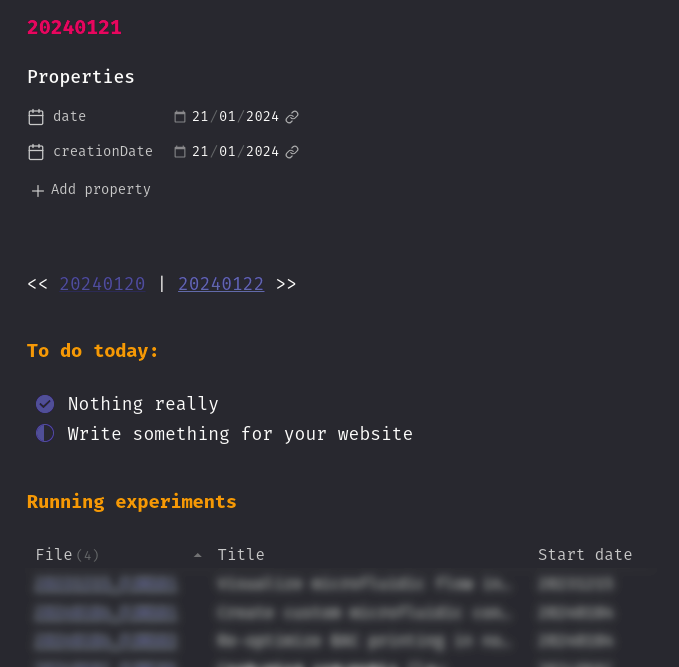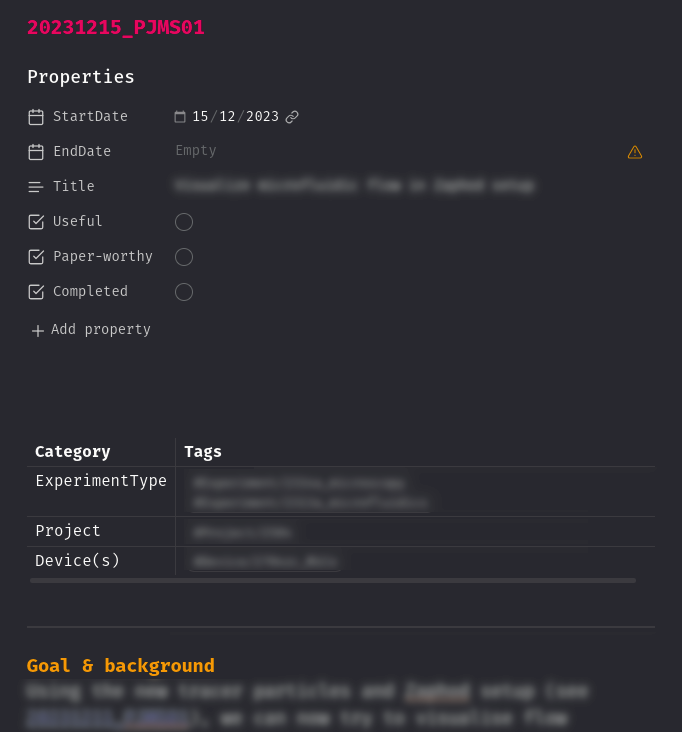Obsidian as a Lab Notebook
In a previous post, I discussed why you would want to use Obsidian as an electronic lab notebook (ELN). Just to quickly recap: Obsidian is flexible, (pretty) open, and free to use. In this post, I will guide you through the practical steps of setting up Obsidian for effective use as an ELN. First, I will explain broadly how everything sticks together, followed by a more in-depth exploration of the configuration details at the end of the post.
Edit on 10-09-2025: because this is pretty popular, I've just made an example vault you can download and start from!
How I use my Obsidian Lab Notebook
I keep separate note types for daily notes, experiments, meetings, literature, and stocks & samples. Finally there are a few special pages. Each type of note has its own folder. I use the powerful Templater plugin to define templates for each note category.
Let's take daily notes as an example. Every day, a new note is automatically generated with the current date, and it's linked to the notes from the previous and next days for easy navigation. This note also includes a section for random thoughts. Plus, with the help of the Obsidian bases, I can add a table showing all the ongoing experiments with links for quick access.
Similarly, when I create a new experimental note, it's given a name automatically1). The note starts with some basic information that I need to fill in, such as a title, start date, checkboxes to mark if the experiment is finished or useful. Then, there's a space for adding tags to make finding experiments later easier. After that, I have a section to describe the experiment's background and purpose, ideally with links to previous or related experiments. Finally, there's a space to jot down notes about what happened during the experiment. To make note-taking even more convenient, I use a couple of extra plugins: Excalidraw for quick drawings and sketches (of a setup, or what you see in a microscope) and numerals for simple calculations right in the notebook. During experiments, you can paste in pictures you take, or just experimental data although obviously you may want to keep an eye on the file sizes.


You can make a customized template for each type of note, automating most of the formatting and naming processes. This way, you're left with the “straightforward” task of just filling the notes up with your science.
While this system works great, the real test is finding the notes you've already written. The simplest way to do this is by searching your database, where you can look for tags, keywords, or anything else that comes to mind. If you're unsure what to search for, the special pages I mentioned earlier come in handy. These pages contain tables created using Obsidian Bases, containing all notes of each category. The tables show relevant properties, making it easy to sort and find the notes as you need.
Finally, stuff like scribbling down ideas and literature notes is also surprisingly convenient using obsidian, check out this guide for instance. This is not really part of a lab notebook I think, but it can be quite convenient, and is easily be done in obsidian as well.
Syncing and Backup
Of course, an electronic lab journal is pretty useless without it being possible to sync between devices, and it outright stupid to use one without some form of backup and/or syncing between devices. You probably want to be able to look at your lab notebook on your phone/tablet/laptop/whatever other device. And In case of a computer crash you don't want to lose all your experiments. For this you can use the payed built-in syncing system of Obsidian, but personally, I use Syncthing which also just works™. But in general any file syncing system (Dropbox, Google Drive, whatever) will probably work. Just make sure that you don't sync the folder containing Obsidian settings, this will lead to weird issues. And please, please, take a backup of this folder regularly in case something weird happens.
Actual usage
With this system in place, the structure and formatting of my lab journal requires minimal thought. And this is good, because I am easily distracted by such things. Everything is more-or-less automatically generated, so I have to focus on the science-y bits. Every morning, when I open Obsidian for the first time, a new daily note is generated if it does not exist yet. I can also make a quick to-do list for today. I can also make daily notes for days in the future, to plan a later to-do.
Starting new experiment is also very easy; when I start a new experiment, I just create a new experiment file, the name is auto-generated. If I collect data, I just use the auto-generated name: no chance of labeling something twice with te same name! I can past pictures of what is happening as well as experimental data or analysis. Easy peasy! All other categories of notes are similarly easy to generate, use, and order.
Final remarks
This is how I've configured Obsidian to serve as my electronic lab notebook. The strength of Obsidian lies in its flexibility - you can create your own categories, folder structure, tags, intricate templates, and virtually anything you desire. It allows for a high degree of customization, enabling you to craft sophisticated systems if that's what you like. After investing a bit of effort upfront, Obsidian operates almost seamlessly for me. I encourage you to give it a try, experiment with it, and change things to fit your working style. Below, I provide a bit more detail about my setup for those interested, but you should definitely adapt stuff to your needs. Don't be afraid to break things!
20251023_PJMS01, but anything you can imagine will work, obviously
Comments
I tried it out and had problems with the daily notes function. I think I did not set up the templater correctly.
When I startup it does not automatically create a new daily note. And when I try to create a new note in the folder, I get an error:"Templater Error: Template parsing error, aborting. Invalid time value". The created note has "untitled" as name and nothing in it. The other templates work for me (experiments, ...).
Googling didnt really help me.
Would appreciate your help since I really want to use that feature :)